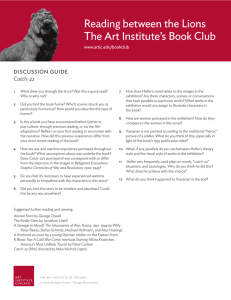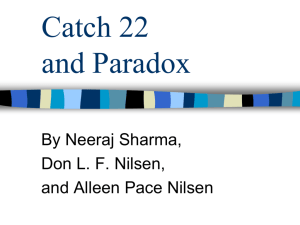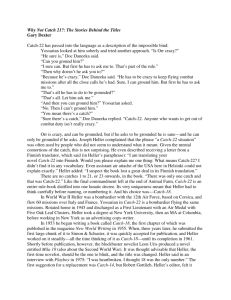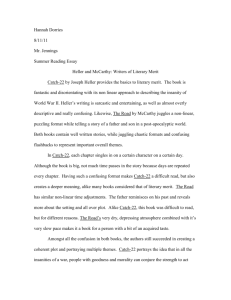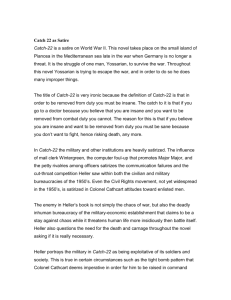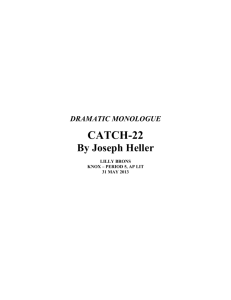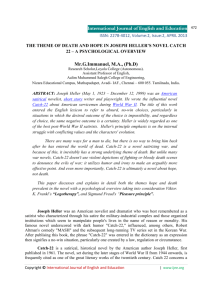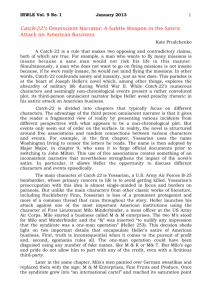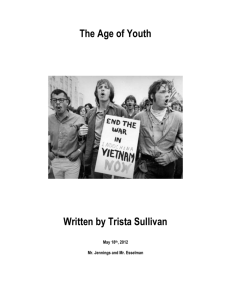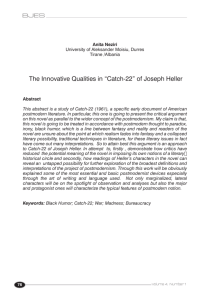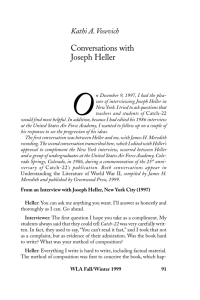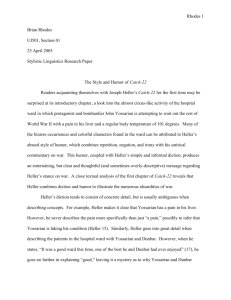Joseph Heller
advertisement
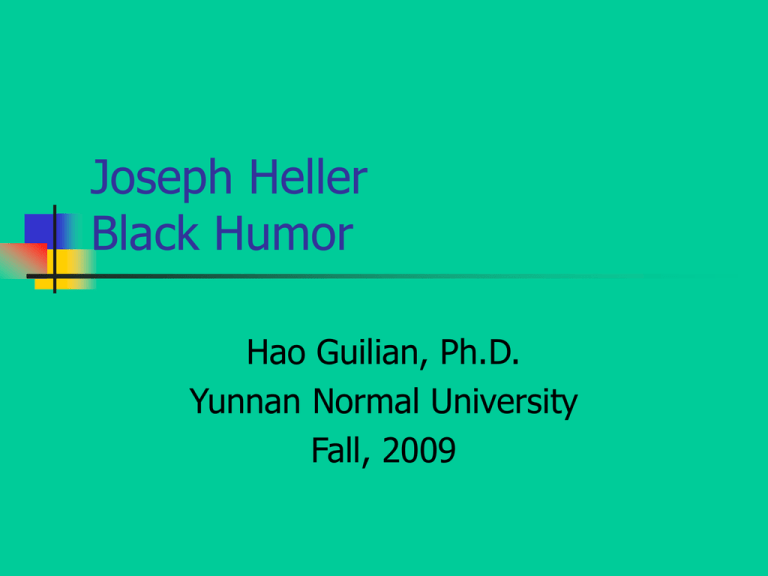
Joseph Heller Black Humor Hao Guilian, Ph.D. Yunnan Normal University Fall, 2009 War novels A war novel is a novel in which the primary action takes place in a field of armed combat, or in a domestic setting (or home front) where the characters are preoccupied with the preparations for, or recovery from, war. It is sometimes referred to as military fiction. The war novel came of age during the nineteenth century. Works such as Leo Tolstoy's War and Peace, about the Napoleonic Wars in Russia, and Stephen Crane's The Red Badge of Courage, about the American Civil War established the conventions of the modern war novel as it has come down to us today. All of these works feature realistic depictions of major battles, animal-like scenes of wartime horrors and violence, and significant insights into the nature of heroism, cowardice, and morality in wartime. World War I and after World War I produced an unprecedented number of war novels, by writers from countries on all sides of the conflict. Ernest Hemingway's Sun Also Rises and John Dos Passos's Three Soldiers, are among a small number of American novels about the First World War. Unlike World War I novels, a European-dominated genre, World War II novels were produced in the greatest numbers by American writers, who made war in the air, on the sea, and in key theatres such as the Pacific Ocean and Asia integral to the war novel. Among the most successful American war novels were Herman Wouk's The Caine Mutiny, James Jones's From Here to Eternity, and Hemingway's For Whom the Bell Tolls, the latter a novel set in the Spanish Civil War. More experimental and unconventional works in the post-war period included Joseph Heller's satirical Catch-22 and Thomas Pynchon's Gravity's Rainbow, an early example of postmodernism. Norman Mailer's The Naked and the Dead, Irwin Shaw's The Young Lions, William Woodruff's Vessel of Sadness and James Jones' The Thin Red Line, all explore the personal nature of war within the context of intense combat. Joseph Heller (1923-1999) American satirical novelist, short story writer and playwright. He wrote the influential novel Catch22 about American servicemen during World War II. Heller is widely regarded as one of the best post-World War II satirists. Although he is remembered primarily for Catch22, his other works center on the lives of various members of the middle class and remain exemplars of modern satire. Joseph Heller at the Miami Book Fair International of 1986 Joseph Heller, 1986 Joseph Heller was born in Coney Island in Brooklyn, New York, the son of poor Jewish parents from Russia. In 1942, at age 19, he joined the U.S. Army Air Corps. Two years later he was sent to Italy, where he flew 60 combat missions as a B-25 bombardier. Experiences that he had during World War II formed the basis for Catch-22. Before Catch-22 was published in 1961, Heller taught at a number of institutions, and wrote a number of short stories, mostly successful. Catch-22 Although he originally did not intend the story to be longer than a novelette, Heller was able to add enough substance to the plot that he felt it could become his first novel. The finished novel describes the wartime experiences of Army Air Corps Captain John Yossarian. Yossarian devises multiple strategies to avoid combat missions, but the military bureaucracy is always able to find a way to make him stay. As Heller observed, "Everyone in my book accuses everyone else of being crazy. Frankly, I think the whole society is nuts -- and the question is: What does a sane man do in an insane society?" Heller has also commented that "peace on earth would mean the end of civilization as we know it" -- perhaps further food for thought when reading Catch-22, in which the concept and circumstances of war are so overwhelming and fundamental. Among other things, Catch-22 is a general critique of bureaucratic operation and reasoning. Resulting from its specific use in the book, the phrase "Catch-22" is common idiomatic usage meaning "a no-win situation" or "a double bind" of any type. Within the book, "Catch-22" is a military rule, the selfcontradictory circular logic that, for example, prevents anyone from avoiding combat missions. In Heller's own words: There was only one catch and that was Catch-22, which specified that a concern for one's safety in the face of dangers that were real and immediate was the process of a rational mind. 'Orr' was crazy and could be grounded. All he had to do was ask; and as soon as he did, he would no longer be crazy and would have to fly more missions. Orr would be crazy to fly more missions and sane if he didn't, but if he was sane he had to fly them. If he flew them he was crazy and didn't have to; but if he didn't want to he was sane and had to. Yossarian was moved very deeply by the absolute simplicity of this clause of Catch-22 and let out a respectful whistle. "That's some catch, that Catch-22," Yossarian observed. "It's the best there is," Doc Daneeka agreed. catch-22? More broadly, catch-22 is a metaphor for the ordinary person caught up in the madness of war or modern social life in general. Heller boils his catch-22 down to this, that “they [i.e., whoever has control] have a right to do anything we can't stop them from doing.” Yossarian cannot go home because the people who run the war won't let him, and it makes no difference what justification they might give for making him stay. Catch-22 stands as a symbol for relations of power, relations that exist even if they are nowhere put down in writing, and it is these relations that are responsible for the misery and senseless death of millions and millions of people. In essence, Heller is pointing to the fundamental nature of modern politics, that, in spite of all talk of democracy and freedom, it is the Milo Minderbenders, in collusion with the petty officers and politicians, who run the show. “When I look up,” Heller says, speaking through Yossarian, “I see people cashing in. I don't see heaven or saints or angels. I see people cashing in on every decent impulse and every human tragedy.” Style Many events in the book are repeatedly described from differing points of view, so the reader learns more about each event from each iteration. The narrative often describes events out of sequence, but events are referred to as if the reader is already familiar with them, so that the reader must ultimately piece together a timeline of events. Much of Heller's prose in Catch-22 is circular and repetitive, exemplifying in its form the structure of a Catch-22. Heller revels in paradox, for example: The Texan turned out to be good-natured, generous and likable. In three days no one could stand him, and The case against Clevinger was open and shut. The only thing missing was something to charge him with. This atmosphere of apparent logical irrationality pervades the whole book. 的确,海勒为我们勾画的关于美国六十年代的现实 使这本书成为“六十年代的最佳小说”,它使人们 认清了当时社会生活中的欺诈、虚幻和操纵的本质。 人们要求讲真话的愿望不仅没有得到满足,反而得 到了更大的舆论控制和更大的谎言。就小说技巧和 结构而言,卡夫卡式的荒诞被发挥到了极致,陀思 妥耶夫斯基式的小人物也逐一粉墨登场,为我们上 演了一场乱哄哄、血淋淋的喜剧。而这场喜剧中的 对话现象又是最值得我们关注的话题之一,它体现 了代表芸芸众生的小人物们不甘命运捉弄、试图在 这个庞大的官僚机器压迫下大声发言的努力,也是 后现代作家对权威和中心进行解构的一种尝试。 Black humor Black humor, in literature, drama, and film, grotesque or morbid humor used to express the absurdity, insensitivity, paradox, and cruelty of the modern world. Ordinary characters or situations are usually exaggerated far beyond the limits of normal satire or irony. Black humor uses devices often associated with tragedy and is sometimes equated with tragic farce. The novels of such writers as Kurt Vonnegut, Thomas Pynchon, John Barth, Joseph Heller, and Philip Roth contain elements of black humor. 当“幽默”成为黑色时,真正发生的决不仅仅是 从黑暗中看到幽默,或以幽默对待黑暗,决没有 那么温良恭俭让,决不是中产阶级趣味的什么含 泪的微笑,黑色幽默是一种颠覆性的语言暴力, 是以残酷应对残酷,以不讲理应对不讲理,是光 脚的不怕穿鞋的,是将世上一切从给定的秩序中 释放出来,打碎一切等级和界限,在事物和事物 之间建立突兀,荒谬,不“合理”,不“自然” 的联系,它要打破世界的光滑外壳,暴露出它的 疯狂和混乱——这完全符合约塞连们的利益,在 混乱中他们才有出奔和逃离的希望。---李敬泽 根据第二十二条军规,疯子可以不执行飞行任 务,但是必须要自己提出申请才行,而自己提 出了申请的士兵又被这同样一条军规认为不是 疯子,因此又必须参加飞行战斗。第二十二条 军规还规定,空军军官只要完成了规定的飞行 次数就可以申请回国,但是同样的这条军规还 规定空军军官无论何时队必须服从长官的命令, 只要长官让你飞,你就还得飞,否则就是违抗 命令。 卡吉尔上校为发觉了自己的无能而感到自豪;科 恩中校创立了一条规定:“唯一允许提问的人就是 那些不提问的人”;谢司科普夫集法官、检察官 和辩护人于一身出现在军事法庭上,给克莱文杰 “由于只有判他罪才能证明他有罪”而定了罪。 小说中,这样荒谬的规定与逻辑比比皆是,都被 称作第二十二条军规,是官僚体制的真正代言人。 最为可怕的是,这样一条无处不在的军规其实并 不存在,它没有什么文本可以让人对它进行“嘲 弄,驳斥,控告,批评,攻击,修正,憎恨,辱 骂,唾弃,撕毁,践踏或者烧掉”。 凡此种种奇思异想的漫画式夸张把讽刺推向了 荒谬的极致,正是由于海勒把大不幸大悲哀当 作了开玩笑的对象,所以产生的效果也就超越 了传统幽默的轻松与愉悦,使读者在哑然失笑 之后对人物的命运深表同情,感慨于这种荒诞 不羁的绝境。在这场普通官兵与官僚体制之间 的对话和交锋过程中,浮现在读者面前的是普 通官兵的被困与无奈,除了小说结尾处作者刻 意安排的奥尔和约塞连以外,他们无法真正摆 脱战争机器的控制,无法真正与官僚体制抗衡 。 Text study: The three incidents Yossarian’s having an operation. 2. Yossarian’s deal with Colonels Cathcart & Korn. 3. Yossarain’s attempt to save Snowden. 1.
